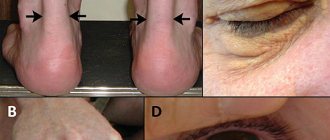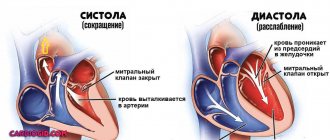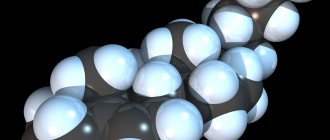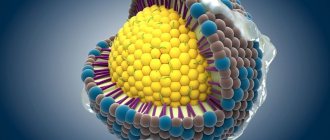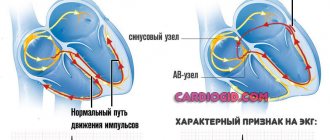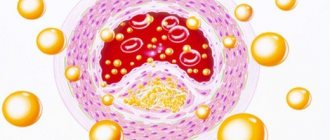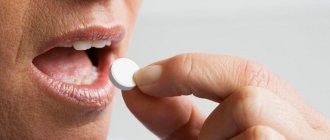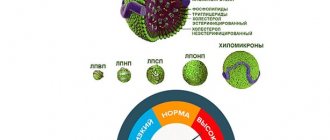Dyslipidemia is a change in the concentration of one or more types of blood lipids: low density lipoproteins (LDL), intermediate lipoproteins (LDL), very low lipoproteins (VLDL), high density lipoproteins (HDL), chylomicrons, triglycerides.
Pathology can be congenital or acquired, be a sign of disease or a risk factor for cardiovascular diseases, pancreatitis. Let's consider the main types of dyslipidemia, their symptoms, and understand the features of diagnosis and treatment.
Types of fat metabolism disorders
What is dyslipidemia? It is a symptom of specific diseases, as well as a consequence of poor nutrition and bad habits. Accordingly, there are many types of fat metabolism disorders. The need to classify and organize them arose quite quickly.
In the international classification of diseases (ICD-10), dyslipidemias are allocated a separate group - E78. This includes all independent pathologies associated with an increase (hyperlipidemia) or decrease (hypolidemia) in fat levels.
By origin, dyslipidemia can be:
- primary (congenital) – caused by gene defects;
- secondary (acquired) – caused by diseases of internal organs, bad habits, and poor diet.
Some experts separately distinguish nutritional dyslipidemia - a disorder of fat metabolism caused by poor diet.
In clinical practice, the division of pathologies proposed by the American Donald Fredrickson is most often used. He divided all hyperlipidemias into 6 groups, using the type of lipids with altered concentrations as the basis for the classification. It was later approved by WHO as the standard nomenclature for disorders associated with increased fat levels.
Fredrickson classification of hyperlipidemia.
| Type | Type of violation | Name of birth defect | Treatment |
| I | Total cholesterol: elevated or normal | Hereditary hyperchylomicronemia | Diet |
| LDL: elevated or normal | |||
| Triglycerides: very elevated | |||
| Chylomicrons: increased | |||
| IIa | Total cholesterol: elevated or normal | Polygenic hypercholesterolemia, hereditary hypercholesterolemia | Statins, vitamin B3 |
| LDL: elevated | |||
| Triglycerides: normal | |||
| IIb | Total cholesterol: elevated or normal | Hereditary mixed hypercholesterolemia | Statins, fibrates, vitamin B3 |
| LDL: elevated | |||
| VLDL: increased | |||
| Triglycerides: elevated | |||
| III | Total cholesterol: elevated | Hereditary dys-beta lipoproteinemia | Fibrates |
| LDL: low or normal | |||
| DILI: increased | |||
| Triglycerides: elevated | |||
| Chylomicrons: many residual particles | |||
| IV | Total cholesterol: elevated or normal | Endogenous hyperlipemia | Vitamin B3 |
| LDL: normal | |||
| VLDL: increased | |||
| Triglycerides: elevated | |||
| V | Total cholesterol: elevated | Hereditary hypertriglyceridemia | Vitamin B3, fibrates |
| LDL: normal | |||
| VLDL: increased | |||
| Triglycerides: very elevated | |||
| Chylomicrons: increased |
Hereditary hypolipidemias include 4 pathologies:
- abetalipoproteinemia (Bassen-Kornzweig syndrome) – absence of VLDL, LDL, chylomicrons in the blood;
- hypobetalipoproteinemia – insufficient LDL content;
- chylomicron retention disease, manifested by the lack of synthesis of these structures;
- hypoalphalipoproteinemia (Tangier Islands disease) – absence of HDL in the blood plasma.
What are lipids, lipoproteins and hyperlipidemia?
There is an opinion that fats are harmful to the body. It's not like that at all. Fats are the most important component of all living organisms, without which life is impossible. They are the main “energy station”; through chemical reactions they produce the energy necessary for metabolism and cell renewal.
Fats become harmful when their content is excessive, especially certain types that lead to atherosclerosis and other diseases - low-density lipids, or atherogenic ones. All fatty substances in the body are divided into 2 groups according to their chemical composition:
The name comes from the Greek lipos - fat. This is a whole group of fat-forming substances in the body, including:
- fatty acids (saturated, monounsaturated, polyunsaturated);
- triglycerides;
- phospholipids;
- cholesterol.
The fatty acids that everyone knows about and which play a big role in the development of atherosclerosis are saturated ones. They are found in animal products. Unsaturated acids, on the contrary, prevent the development of atherosclerosis; they are found in vegetable oils and seafood (omega 3, omega 6, omega 9 and others).
Triglycerides are neutral fats, derivatives of glycerol, which are the main suppliers of energy. Their increased content contributes to the development of diseases. Phospholipids contain a phosphoric acid residue and are necessary for the maintenance of nervous tissue.
Finally, everyone knows cholesterol - the main culprit of many diseases, and the most common “disease of the century” - atherosclerosis. It comes in two types: high density, or “good cholesterol,” and low density, or “bad cholesterol.” It is this substance that is deposited in organs, causing fatty degeneration, in blood vessels, causing circulatory problems.
Lipoproteins
These are more complex compounds, including lipids and protein molecules. They are divided into:
- chylomicrons, which perform a transport function, deliver fat from the intestines to tissues and organs, including promoting its deposition in the subcutaneous tissue;
- lipoproteins of various densities - high (HDL), low (LDL), intermediate (LDL) and very low (LDL).
Lipoproteins and low-density lipids, chylomicrons contribute to the accumulation of fatty substances and “bad” cholesterol in the body, that is, the development of hyperlipidemia, against which diseases develop.
Primary, secondary causes of the disease
Primary lipid metabolism disorders are inherited. They are rare. The most common pathologies are combined hyperlipidemia and endogenous hyperlipidemia. Secondary dyslipidemia is much more common.
A reduced content of certain fat groups may be associated with:
- hyperfunction of the thyroid gland;
- chronic infections, including hepatitis C;
- the presence of malignant tumors;
- malnutrition;
- impaired absorption of nutrients from the digestive tract (malabsorption syndrome);
- extensive burns.
Causes of secondary hyperlipidemia:
- diabetes;
- thyroid insufficiency;
- chronic kidney disease;
- nephrotic syndrome;
- alcohol abuse;
- smoking;
- pregnancy (considered normal);
- taking beta blockers, thiazide diuretics, estrogen preparations.
What are the causes of hyperlipidemia?
Many organs play a role in the metabolism of fats in the body: liver, kidneys, endocrine system (thyroid gland, pituitary gland, gonads), and also influence lifestyle, nutrition, and so on. We also recommend that you study information about the symptoms of hyperkalemia on our portal. Therefore, the causes of hyperlipidemia may be the following:
- poor nutrition, excess intake of fatty substances;
- liver dysfunction (with cirrhosis, hepatitis);
- impaired renal function (with hypertension, pyelonephritis, renal sclerosis);
- decreased thyroid function (myxedema);
- dysfunction of the pituitary gland (pituitary obesity);
- diabetes;
- decreased function of the gonads;
- long-term use of hormonal drugs;
- chronic alcohol intoxication;
- hereditary characteristics of fat metabolism.
Important: You should not think that the listed reasons necessarily lead to obesity. We are talking about hyperlipidemia - an increased content of fatty substances in the blood and organs, and not about subcutaneous fat deposits.
What are the dangers of dyslipidemia?
Increased lipid levels are one of the leading risk factors for the development of atherosclerosis, and when combined with a high concentration of triglycerides, pancreatitis. Therefore, people with hyperlipidemia have an increased chance of developing peripheral artery disease, coronary heart disease, brain disease, as well as their most severe complications: myocardial infarction, stroke, ischemic necrosis of the feet.
The likelihood of cholesterol plaques appearing on the walls of blood vessels varies with different types of dyslipidemia. A high risk of developing atherosclerosis in people with types IIa, IIb, III of hyperlipidemia, moderate in cases IV, V. Type I atherogenicity has not been proven.
Hypolilipidemia is dangerous due to a lack of nutrients, primarily fatty acids and fat-soluble vitamins. Hereditary forms of dyslipidemia are especially difficult. They can lead to serious disturbances in the child’s growth: retardation in physical and mental development, and the appearance of neurological symptoms.
Forms of dyslepidemia
Forms of dyslipidemia can be distinguished based on three criteria. It’s worth starting with the factor in the formation of pathology.
Accordingly they are called:
- Primary form. It becomes the result of burdened heredity. Again, even if there are relatives with such a problem, with proper prevention it is possible to avoid a repetition of the negative scenario.
- Secondary form. develops as an acquired tendency against the background of a normal tendency, no higher than that of others. For example, as a result of diabetes mellitus, hypothyroidism (thyroid problems). Prevention puts an end to the issue, although it is almost impossible to understand what was the main reason. A whole range of violations plays a role.
The second classification criterion is the duration and nature of the pathology:
- Transient or transient appearance. Accompanied by problems on a temporary basis. After stopping the increased consumption of fats, everything goes away on its own. No medical care.
- Permanent type. Much more complex. Usually associated with the course of one or another pathological process. Requires treatment and intensive use of medications.
Fredrickson classification
The Fredrickson classification of dyslipidemia is generally accepted.
It is based on the type of fatty substance that becomes the culprit of the disorder.
In total, there are 6 types of pathological process:
- Forms I, IIb, III, IV, V are characterized by an excessive concentration of triglycerides, less cholesterol.
They are accompanied by non-critical disorders in the early stages. The end result in all situations is atherosclerosis of varying severity.
The reasons, however, are always different. This simplifies the diagnostic strategy and identification of the primary factor.
- Dyslipidemia type 2a (IIa) is caused only by cholesterol.
There is no fundamental difference between them. 5 out of 6 forms are atherogenic, that is, they cause blockage of blood vessels with plaques. Apart from one.
Triglycerides refer to a large complex of substances:
- Lipoproteins, which are divided into 4 types according to density: very low (VLDL), low (LDL), intermediate (LDLP) and high (HDL).
- Chylomicrons.
The type does not play a special role, but only affects the rate of development of atherosclerosis and the aggressiveness of the pathological process.
Using this criterion, it is also possible to more accurately assess the course and dynamics of the disorder.
High-density lipoproteins have beneficial properties that are exactly the opposite. They do not settle on the walls of the arteries. They cleanse them and remove fats. This type cannot be called pathological.
Symptoms and clinical manifestations
The signs of different types of dyslipidemia are very different and depend on the cause of the lipid metabolism disorder. Often, pathology is discovered by chance during a routine examination or when visiting a doctor for other diseases. After all, biochemical changes in blood composition develop long before the first symptoms appear.
Primary pathologies associated with high fat content are clinically manifested by obesity and the appearance of visible cholesterol deposits (xanthomas, xanthelasma). Signs of a decrease in lipoprotein levels due to hereditary defects are impaired absorption of fats, signs of vitamin E deficiency. Secondary dyslipidemia has symptoms characteristic of the underlying disease.
Clinical manifestations of hereditary dyslipidemias.
| Disease | Symptoms |
| Hereditary hyperchylomicronemia |
|
| Hereditary hypercholesterolemia |
|
| Hereditary dysbetalipoproteinemia |
|
| Endogenous hyperlipidemia |
|
| Hereditary hypertriglyceridemia | xanthomas |
| Bassen-Kornzweig syndrome |
|
| Tangier Islands disease |
|
| Hypobetalipoproteinemia | With some types of mutations it can be asymptomatic. Severe forms resemble the course of Bassen-Kornzweig syndrome |
| Chylomicron retention disease |
|
Symptoms of dyslipidemia development
Dyslipidemia does not appear for quite a long time, and the patient does not even know about the disorder in fat metabolism.
Symptoms begin to appear during the period when cholesterol rises above standard levels by several units and begins to manifest itself at the physical level:
- Spots of a yellowish tint appear on the eyelids of the eye organ - xanthelasma;
- The gray or yellowish color throughout the peripheral part of the ocular cornea is the lipoid arc. Most often manifests itself in patients over 50 years of age;
- Xanthomas on the knee joints, on the ankle muscles, on the elbow joint, on the fingers, and on the tendons;
- Cardiac ischemia develops and angina pectoris appears.
Only a laboratory diagnostic method can establish the diagnosis of dyslipidemia.
Basic diagnostic methods
There is only one way to establish the presence of dyslipidemia: take a lipid profile - a blood test showing the quantitative content of various fat fractions, as well as their ratio. A more difficult task is to find out the cause of the violation. This can be done by studying and analyzing the life history of the patient, his immediate family, the patient’s complaints, and clinical symptoms.
To clarify the nature of pathological changes, a more detailed instrumental examination is required. Dyslipidemia may require the following tests:
- electrocardiograms;
- Ultrasound of the heart;
- Dopplerography of blood vessels;
- angiography;
- blood tests for thyroid hormones;
- immunological tests;
- biochemical, general blood test;
- general urinalysis;
- genetic testing.
Which doctor should I contact?
If you suspect that you or someone close to you has a fat metabolism disorder, contact your local physician. He will conduct an initial examination, issue a referral for blood and urine tests, and if the examination results are good or relatively good, he will prescribe treatment.
Dyslipidemia may require consultation with specialists if it is accompanied by a serious illness. Doctors of various profiles deal with pathologies of lipid metabolism:
- cardiologist;
- gastroenterologist/hepatologist;
- immunologist;
- geneticist;
- nephrologist;
- phlebologist/angiologist;
- vascular, neurosurgeon;
- nutritionist.
Features of treatment
The treatment strategy for dyslipidemia depends on the cause of the disease. Most mild forms of disorders can be corrected by changing your diet and giving up bad habits. Advanced forms of hyperlipidemia require medication. In the presence of atherosclerotic plaques, it is advisable to combine drug and surgical treatment. Secondary types of dyslipidemia are eliminated by treatment of the underlying diseases.
Proper nutrition
By adjusting your diet you can influence your lipid metabolism. Each type of dyslipidemia has its own dietary guidelines. But there are general rules that apply to the vast majority of metabolic lipid disorders:
- Eat often, in small portions. The optimal number of meals is 5-6 times/day.
- Monitor your daily calorie intake. Dyslipidemia of all forms often occurs with the development of obesity.
- Drink 1.5-2 liters of water/day. It is involved in all metabolic processes, including lipid metabolism.
- Give preference to dishes prepared by boiling, baking, and stewing. Fried, smoked, salted, pickled, deep-fried foods are best avoided as much as possible.
- Avoid products with trans fats. Margarine, as well as store-bought cookies, baked goods, and roasted nuts are in the area of close attention. Always check their nutritional facts to see if they contain trans fats.
- Add foods rich in unsaturated fats to your diet: vegetable oils, seeds, nuts, fatty fish (mackerel, herring, tuna, anchovy, mackerel), avocado.
- Eat several different vegetables, fruits, a portion of greens, and porridge every day.
- Alcohol consumption should not go beyond generally accepted norms: up to 14 g of ethyl alcohol/day for women, up to 28 g for men.
For hyperlipidemia, it is very important to reduce the amount of animal fats, as well as coconut and palm oil. These foods contain high amounts of cholesterol. Egg whites are allowed unlimitedly, but the amount of yolk is limited.
Primary dyslipidemia, accompanied by a decrease in the level of chylomicrons or lipoproteins, requires additional intake of fat-soluble vitamins (A, D, E, K). To compensate for the deficiency of fatty acids, it is recommended to increase the consumption of unsaturated fats: vegetable oils, nuts, dairy products, ground flaxseeds, sesame seeds, fish.
Chronic diseases that occur with dyslipidemia require specific, more strict diets.
Conservative treatment
Hypercholesterolemia can be easily corrected without medication. You can reduce the level of total cholesterol, triglycerides, and LDL:
- Getting rid of extra pounds. Losing body weight has a beneficial effect on fat metabolism and reduces the load on the heart muscle.
- Giving up cigarettes. This bad habit creates ideal conditions in the body for the formation of atherosclerotic plaques and the formation of blood clots.
- By moving more. The minimum time you need to devote to physical activity daily is 30 minutes.
Similar treatments for dyslipidemia are used for most secondary diseases.
Medications
If there is a persistent increase in fat that is not removed by diet or by giving up bad habits, the patient is prescribed lipid-lowering drugs. These medications reduce the amount of bad fats and increase the amount of good ones. The choice of medication for the treatment of dyslipidemia primarily depends on the type of disorder when:
- elevated LDL levels - statins, medications that prevent the absorption of cholesterol or accelerate its elimination;
- increasing the concentration of DILI, VLDL – fibrates;
- high triglycerides – vitamin B3 (nicotinic acid).
Other medications are necessary to eliminate symptoms and reduce the risk of complications:
- atherosclerosis - drugs that normalize blood pressure, prevent the formation of blood clots, and improve tissue nutrition;
- diabetes mellitus – medications that lower blood sugar;
- dysfunction of the thyroid gland - medications that reduce or increase the level of thyroid-stimulating hormones;
- malabsorption syndrome – digestive enzymes.
Specific drug treatments for primary dyslipidemia with reduced fat have not been developed. Typically, such patients are prescribed drugs that eliminate the consequences of the disorders. For example, vitamin complexes.
Folk remedies
In the initial stages, dyslipidemia with increased levels of atherogenic fats can be treated with herbal remedies. Proven folk methods for treating hypercholesterolemia include:
- Linseed oil. Contains a large amount of omega-3 fatty acids, which are natural lipid-lowering agents. It is also beneficial for heart muscle health. It is taken in its pure form: a tablespoon in the morning before meals. You can also season salads with flaxseed oil.
- Garlic. A powerful cholesterol lowering agent. The effect is more pronounced in its raw form. If you don't like the taste of garlic, use it in your cooking or take capsules containing garlic extract.
- Red rowan. You can lower cholesterol by eating 5 fresh fruits daily 3-4 times a day. After 5 days, take a 10-day break and repeat the course twice more. This recipe is suitable for winter treatment: berries collected during frost have the strongest effect.
- Beans. Has a mild lipid-lowering effect. It is eaten boiled, sprinkled with olive oil, adding a little salt and black pepper (optional). To achieve results, eat at least 100 g of beans daily.
- Propolis tincture. Take 7 drops of medicine 3 times a day half an hour before meals. It is better to drink propolis dissolved in a tablespoon of water. Duration of treatment – 4 months.
The given recipes are well tolerated by most patients. The risk of unwanted consequences can be further reduced by discussing your plans with your doctor. It is especially recommended not to neglect this opportunity for people with chronic diseases.
Hyperlipidemia - treatment and diet
Treatment of hyperlipidemia is, first of all, a radical change in eating habits, adherence to a proper diet and the beginning of physical activity.
Overweight and obese people need to get rid of extra pounds. The most important dietary recommendations include reducing the consumption of foods high in fat and cholesterol (fatty dairy and meat products, organ meats and egg yolks), increasing the consumption of fiber, vegetables, fruits and fish, and avoiding processed fats (baking and frying should be used instead of frying). steam cooking). In addition, you should eat 4-5 meals a day and not snack in between.
Don't forget to have breakfast, and give up a late and hearty dinner. If dietary changes are not enough, drug therapy must be introduced. Hyperlipidemia, especially mixed, often leads to coronary heart disease or heart attack.
Literature
- O. O. Soloshenkova, I. I. Chukaeva, N. V. Orlova. Dyslipidemia in clinical practice. Part 1, 2009
- T. I. Turkina, M. Yu. Shcherbakova. Features of dyslipidemia in children, 2011
- Anne Carol Goldberg, MD. Hypolipidemia, 2018
- James Roland. Dyslipidemia: What You Need to Know, 2017
Website editors
A team of authors with higher and secondary medical education, many years of experience in practical medicine, highly specialized specialists and general practitioners.
All articles by the author
